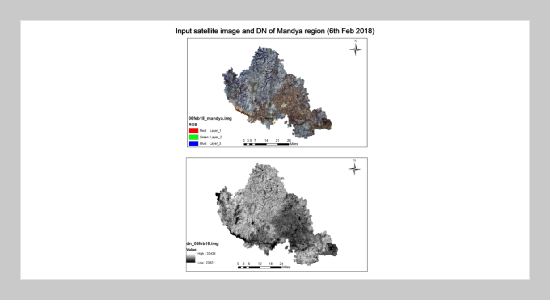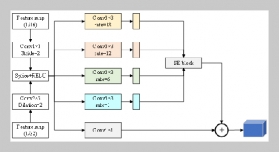REFERENCES
- [1] M Bisquert, J. M. Sánchez, R. López-Urrea, and V. Caselles. Estimating high resolution evapotranspiration from disaggregated thermal images. Remote Sensing of Environment, 187:423–433, 2016.
- [2] Qinqin Sun, Jianjun Tan, and Yonghang Xu. An ERDAS image processing method for retrieving LST and describing urban heat evolution: A case study in the Pearl River Delta Region in South China. Environmental Earth Sciences, 59(5):1047–1055, jan 2010.
- [3] Marina Stathopoulou and Constantinos Cartalis. Day time urban heat is lands from LandsatETM+andCorine land cover data: An application to major cities in Greece. Solar Energy, 81(3):358–368, 2007.
- [4] Stefania Bonafoni and Chaiyapon Keeratikasikorn. Land surface temperature and urban density: Multiyear modeling and relationship analysis using modis and landsat data. Remote Sensing, 10(9), 2018.
- [5] Lidia Vlassova, Fernando Pérez-Cabello, Marcos Rodrigues Mimbrero, Raquel Montorio Llovería, and Alberto García-Martín. Analysis of the relationship between land surface temperature and wildfire severity in a series of landsat images. Remote Sensing, 6(7):6136– 6162, 2014.
- [6] Salman Özupekce. Use of Land Surface Temperature (Lst) Data inthe Determination of High Areas of Forest Fire Risk in Erdemli District. Journal of International Social Research, 11(57):227–232, 2018.
- [7] Ruyan He, Yufang Jin, Maziar M Kandelous, Daniele Zaccaria, Blake L Sanden, Richard L Snyder, Jinbao Jiang, and Jan W Hopmans. Evapotranspiration estimate over an almond orchard using Landsat satellite observations. Remote Sensing, 9(5), 2017.
- [8] B. N. Aryalekshmi, Rajashekhar C. Biradar, and J. MohammedAhamed. Thermal imaging techniques in agricultural applications. International Journal of Innovative Technology and Exploring Engineering, 8(12):2162–2168, oct 2019.
- [9] Ann Kathrin Holtgrave, Michael Förster, Felix Greifeneder, Claudia Notarnicola, and Birgit Kleinschmit. Estimation of Soil Moisture in Vegetation Covered Floodplains with Sentinel-1 SAR Data Using Support Vector Regression. PFG - Journal of Photogrammetry, Remote Sensing and Geoinformation Science, 86(2):85–101, apr 2018.
- [10] Syed Muhammad Zubair Younis and Javed Iqbal. Estimation of soil moisture using multispectral and FTIR techniques. Egyptian Journal of Remote Sensing and Space Science, 18(2):151–161, 2015.
- [11] S K Dash and J. C.R. Hunt. Variability of climate change in India, 2007.
- [12] Lingli Wang and John J. Qu. Satellite remote sensing applications for surface soil moisture monitoring: A review, 2009.
- [13] Ricardo Trezza, Richard G Allen, and Masahiro Tasumi. Estimation of actual evapotranspiration along the Middle Rio Grande of New Mexico using MODIS and landsat imagery with the METRIC model. Remote Sensing, 5(10):5397–5423, 2013.
- [14] Geng Ming Jiang and Ronggao Liu. Retrieval of sea and land surface temperature from SVISSR/FY2C/D/Emeasurements. IEEE Transactions on Geoscience and Remote Sensing, 52(10):6132–6140, 2014.
- [15] C. Ottlé and D Vidal-Madjar. Estimation of land surface temperature with NOAA9 data. Remote Sensing of Environment, 40(1):27–41, 1992.
- [16] A Rajeshwari. ESTIMATION OF LAND SURFACE TEMPERATURE OF DINDIGUL DISTRICT USING LANDSAT 8 DATA. International Journal of Research in Engineering and Technology, 03(05):122–126, 2014.
- [17] Ugur Avdan and Gordana Jovanovska. Algorithm for automated mapping of land surface temperature using LANDSAT8 satellite data. Journal of Sensors,2016,2016.
- [18] Emily G. Kullberg, Kendall C. DeJonge, and José L. Chávez. Evaluation of thermal remote sensing indices to estimate crop evapotranspiration coefficients. Agricultural Water Management, 179:64–73, 2017.
- [19] William Kustas and Martha Anderson. Advances in thermal infrared remote sensing for land surface modeling. Agricultural and Forest Meteorology, 149(12):2071– 2081, 2009.
- [20] USGS. Landsat Missions, 2019.
- [21] Larry M. McMillin. Estimation of sea surface temperatures from two infrared window measurements with different absorption. Journal of Geophysical Research, 80(36):5113–5117, dec 1975.
- [22] OfferRozenstein, ZhihaoQin, Yevgeny Derimian,and Arnon Karnieli. Derivation of land surface temperature for landsat-8 TIRS using a split window algorithm. Sensors (Switzerland), 14(4):5768–5780, 2014.
- [23] Zhao Liang Li, Bo Hui Tang, Hua Wu, Huazhong Ren, Guangjian Yan, Zhengming Wan, Isabel F. Trigo, and José A. Sobrino. Satellite-derived land surface temperature: Current status and perspectives, 2013.
- [24] ARCGIS. Chapter 5 Geospatial Modeling 5.1 Rationale 5.2 SEBAL modeling for evapotranspiration 5.3 Penman-Monteith method for evapotranspiration 5.4 Runoff modeling 5.5 Recharge modeling 5.6 Weighed Overlay Analysis using GIS 5.1 Rationale. Technical report.
- [25] H. R. Shwetha and D. Nagesh Kumar. Performance evaluation of satellite-based approaches for the estimation of daily air temperature and reference evapotranspiration. Hydrological Sciences Journal, 63(9):1347–1367, jul 2018.
- [26] Athos Agapiou, Nikos Papadopoulos, and Apostolos Sarris. Monitoring olive mills waste disposal areas in Crete using very high resolution satellite data. Egyptian
Journal of Remote Sensing and Space Science, 19(2):285– 295, 2016.
- [27] WGMBastiaanssen. Remote Sensing in Water Resources Management : The State of the Art. 1998.
- [28] José A. Sobrino, Juan C. Jiménez-Muñoz, Guillem Sòria, Mireia Romaguera, Luis Guanter, José Moreno, Antonio Plaza, and Pablo Martínez. Land surface emissivity retrieval from different VNIR and TIR sensors. In IEEE Transactions on Geoscience and Remote Sensing, volume 46, pages 316–327, 2008.
- [29] Kalifa Goïta and Alain Royer. Surface temperature andemissivity separability overland surface from combined tir and swir avhrr data. IEEE Transactions on Geoscience and Remote Sensing, 35(3):718–733, 1997.
- [30] Andrew M. Coutts, Richard J. Harris, Thu Phan, StephenJ.Livesley, Nicholas S.G. Williams, and NigelJ. Tapper. Thermal infrared remote sensing of urban heat: Hotspots, vegetation, and an assessment of techniques for use in urban planning. Remote Sensing of Environment, 186:637–651, 2016.
- [31] De Cai Wang, Gan Lin Zhang, Ming Song Zhao, Xian Zhang Pan, Yu Guo Zhao, De Cheng Li, and Bob Macmillan. Retrieval and mapping of soil texture based on land surface diurnal temperature range data from MODIS. PLoS ONE, 10(6), 2015.
- [32] Masahiro Tasumi, Richard G Allen, Ricardo Trezza, and James L Wright. Satellite-based energy balance to assess within-population variance of crop coefficient curves. Journal of Irrigation and Drainage Engineering, 131(1):94–109, jan 2005.
- [33] Rizqi I. Sholihah, Bambang H. Trisasongko, Diar Shiddiq, La OdeS. Iman, Selamet Kusdaryanto, Manijo,and Dyah R. anuju. Identification of Agricultural Drought Extent Based on Vegetation Health Indices of Landsat Data: Case of Subang and Karawang, Indonesia. Procedia Environmental Sciences, 33:14–20, 2016.
- [34] Anju Bala, Prakashkiran S Pawar, Anil Kumar Misra, and Kishan Singh Rawat. Estimation and validation of actual evapotranspiration for wheat crop using SEBAL model over Hisar district, Haryana, India. Current Science, 113(1):134–141, 2017.
















